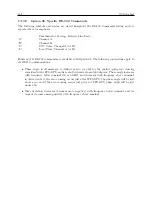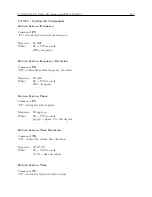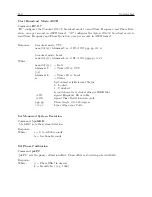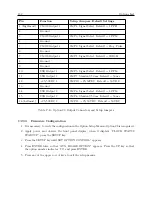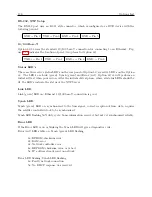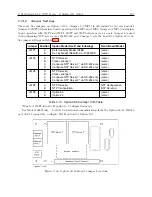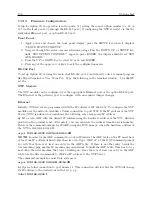
198
Options List
C.21.3
Firmware Configuration.
Setup for Option 32/33 operation is in two parts: (1) setting the correct option number (i.e. 32 or
33) via the front panel, or through the RS-232 port; (2) configuring the NTP server(s) via the the
individual Ethernet port, or option RS-232 port.
Front Panel
1. Apply power and observe the front panel display; press the SETUP key when it displays
“CLOCK STATUS STARTUP”.
2. Navigate through the series of menu selections, using either the DOWN, UP or SETUP key,
until “SET OPTION CONTROL?” appears; press ENTER; the display should read “SET
AUX. BOARD?”
3. Press the UP or DOWN key to select 32 or 33 and ENTER.
4. Press any of the upper row of keys to exit the configuration menu.
RS-232 Port
To set up Option 32/33 using the main clock RS-232 port, you will need to use a terminal program
like HyperTerminal or Tera Term Pro. Type the following in the terminal window, “1,8,1088XI”
set the .
NTP Module.
The NTP module can be configured over the appropriate Ethernet port or the option RS-232 port.
The Ethernet is the preferred port to configure, with no required jumper changes.
Ethernet
Initially, NTP servers are programmed with the IP address of 192.168.0.232. To configure the NTP
module over the network, establish a Telnet connection to port 9999. If the IP address of the NTP
Server (NTS) is unknown or undefined, the following sets a temporary IP address:
a)
Set a static ARP with the desired IP address using the hardware address of the NTS, which is
printed on the product label. Alternately, you can calculate the address from the serial number.
Below is the command example for WinXP, using the DOS prompt, when the hardware address of
the NTS is 00-20-4A-02-64-0B.
arp -s 192.168.0.232 00-20-4A-02-64-0B
NOTE:
In order for the ARP command to work in Windows, the ARP table on the PC must have
at least one IP address defined other than its own. Type “ARP A” at the DOS command prompt
to verify that there is at least one entry in the ARP table. If there is no other entry beside the
local machine, ping another IP machine on your network to build the ARP table. This has to be a
host other than the machine that you’re working on. Once there is at least one entry in the ARP
table, use the listed commands to ARP an IP address to the NTP Server.
The command example for most Unix systems is:
arp -s 192.168.0.232 00:20:4A:02:64:0B
b)
Open a telnet connection to port number 1. This connection will fail, but the NTS will change
its IP address to the desired one in that step, e.g.
telnet 192.168.0.232 1
Summary of Contents for 1088A
Page 4: ...iv ...
Page 6: ...vi ...
Page 18: ...xviii LIST OF FIGURES ...
Page 23: ...1 4 Attaching Rack Mount Ears to 1088A B Series Clocks 3 Figure 1 2 Attaching Rack Mount Ears ...
Page 24: ...4 Unpacking the Clock ...
Page 32: ...12 Front and Rear Panels ...
Page 38: ...18 Connecting Inlet Power Input and Output Signals ...
Page 46: ...26 GPS Antenna and Cable Information ...
Page 48: ...28 Setting Internal Jumpers Figure 5 1 Model 1088B Main Board ...
Page 76: ...56 The Setup Menus ...
Page 112: ...92 Serial Communication and Command Set ...
Page 127: ...B 4 Physical Dimensions 107 Figure B 1 Suggested Mounting of the AS0094500 Surge Arrester ...
Page 128: ...108 Using Surge Arresters ...
Page 145: ...C 5 Option 04 Parallel BCD Output 125 Figure C 4 Option 04 Output Jumper Settings ...
Page 146: ...126 Options List Figure C 5 Option 04 Board Layout and Jumper Locations ...
Page 166: ...146 Options List Figure C 12 Option 17 Board Layout and Jumper Locations ...
Page 187: ...C 16 Option 20A Four Fiber Optic Outputs 167 Figure C 22 Option 20A Jumper Locations ...
Page 194: ...174 Options List Figure C 24 Option 23 Internal Jumper Setup ...
Page 196: ...176 Options List Figure C 25 Option 27 Jumper Locations ...
Page 214: ...194 Options List Figure C 28 Option 29 Connector Signal Locations ...
Page 270: ...250 Options List ...

